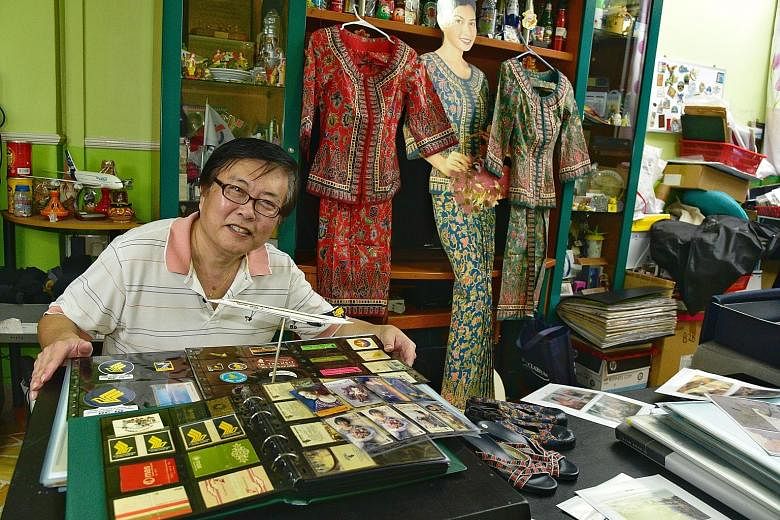Singapore's national airline was nearly named after Mercury but a protest in Malaysia prevented it from happening.
Mr Eddie Yong told The Sunday Times this little-known story of the naming of the airline in Singapore which was newly formed in January 1972.
He showed a Straits Times job advertisement dated March the same year. The headline read "Mercury Singapore Airlines".
Mr Yong, 58, a building manager and an avid collector of SIA memorabilia, said the airline in Singapore wanted to retain the well-known acronym MSA, which stood for Malaysia-Singapore Airlines, after the airline split in 1972.
But the plan was blocked following widespread protests in Malaysia.
The airline in Singapore was then named Singapore Airlines (SIA) and in October 1972, Malaysia Airlines (MAS) was formed.
Even though it did not secure the coveted MSA initials, SIA went on to capture people's imagination with the help of local start-up advertising firm Batey, which handled its marketing.
Mr Yong's pocket albums are filled with phone cards, stickers and matchboxes given to passengers in the days when smoking was allowed on flights. Some were printed with reproductions of intricate hand-drawn art, others with pictures of the world-famous Singapore Girl.
Wearing the sarong kebaya created by French designer Pierre Balmain back in 1968, the Singapore Girl also travelled the world in lavish, full-page advertisements in international magazines, showing her smile and svelte figure.
Mr Yong collects some of his memorabilia by buying stacks of old magazines and pulling out the SIA advertisements, which he keeps in pocket files.
He even has a few sets of the sarong kebaya, purchased from former stewardesses on eBay and even the Sungei Road flea market. He is still trying to track down the purple version worn by the highest-ranking stewardess on the plane, the in-flight supervisor.
Mr Yong started his collection after being inspired by an exhibition celebrating the airline's 50th anniversary in 1997.
The airline's history goes back to 1947, when it was part of Malayan Airways.
Mr Yong's Housing Board flat in Toa Payoh is packed with SIA memorabilia.
"It's sometimes quite hard to find things, I can't remember where they are," he said, laughing. But what he could find showed how the airline grew in the 1970s and 1980s.
There is a double-spread broadsheet advertisement taken out in Nanyang Siang Pau in 1974, showing a fleet of SIA Boeing 747 jumbo jets sporting the muscular bulge of the aircraft's cockpit and upper deck.
SIA flew 747s from the beginning (1972), and once operated the world's largest 747 fleet with 51 planes.
Mr Yong is not the only fanboy. Mr Chris Wong has been a collector since the 1980s.
The 47-year-old environmental engineer, who also collects Cathay Pacific and Thai Airways memorabilia, among others, said SIA's marketing was top-notch.
"Other airlines were wearing the regular uniform with squarish shoulders when (SIA) came up with the sarong kebaya," he said.
"It had a wide range of souvenirs, with its own branding on every product."
In Mr Wong's collection are SIA-branded coasters, playing cards, bookmarks and even vinyl records of SIA theme music.
In the past, passengers could also request free postcards or aerogrammes, on which they could write messages and pass to the crew for posting wherever they landed.
Mr Wong said these little things went a long way in promoting the brand, as they carried the airline's logo and pictures.
SIA said it has also taken steps to ensure its history is preserved and used to reinforce its core values to its staff.
The airline has its own archives of historical material dating back to the 1940s, including an in-house newsletter published since 1972.
Both men said they remain fans of the airline even as SIA faces strong headwinds in the aviation industry. Last month , the airline reported its first quarterly loss in five years.
SIA chief executive Goh Choon Phong said earlier last month that job cuts are likely as the airline embarks on a business review.
Mr Yong and Mr Wong said they will continue to expand their collections.
"Museums have their own priorities and budget constraints. They generally keep some SIA stuff but they don't go all out to keep everything. And books don't publish the finer details," said Mr Wong.
"You have to get them from these memorabilia...They trace SIA's journey from (its) humble beginnings to the big brand it is today."


